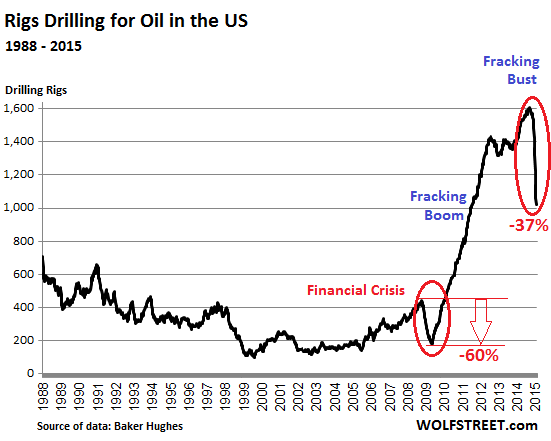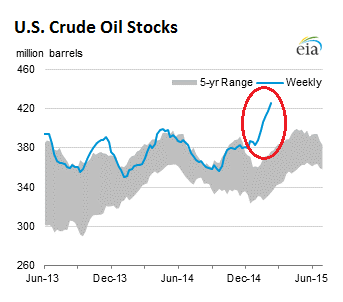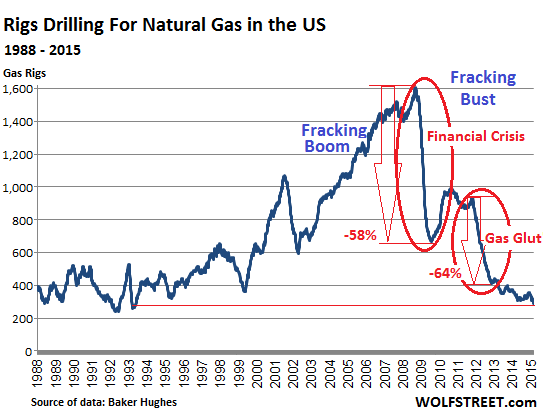The fracking bust that is following the phenomenal fracking boom is deepening relentlessly, week after week, and there is still no respite in sight.
Drilling activity peaked in October last year, when 1,609 rigs were drilling for oil, with a four-month lag behind oil prices. But by October it was clear that the oil-price plunge wasn’t a blip, and in November oil fell off the chart. It was then that the industry reacted with vertigo-inducing rapidity. And the number of rigs drilling for oil, which Baker Hughes publishes every Friday, began to plummet.
In the latest reporting week reported Friday, drillers idled an additional 34 oil rigs. Now only 1,019 rigs are still drilling for oil, down 590 rigs from the October peak, a 37% plunge in 19 weeks. The steepest rig-count plunge in the data series.
But drillers have to service their mountain of debt with which the fracking boom was funded. They can’t afford to cut production. To stay alive, they cut operating cost and capital expenditures, and they’re laying people off. But they focus their remaining resources on the most productive plays, using the most efficient technologies, with a single-minded focus on raising production while spending less.
The hope is that this strategy will get them through the oil bust if it doesn’t last too long. But because everyone is thinking in those terms, US production overall continues to rise – it averaged an estimated 9.2 million barrels per day in January.
Given lackluster demand, crude oil inventories are piling up into record territory. Excluding the Strategic Petroleum Reserve, they rose by another 7.7 million barrels last week to 425.6 million barrels, according to the Energy Information Administration. The highest level in the weekly data going back to 1982. Oil inventories are now 63.3 million barrels, or 17.5%, above the already high inventories at the same time last year.
The surging trajectory of those crude oil stocks has been making a mockery of the 5-year range (gray) and seasonal fluctuations:
Apparently, due to numerous recent changes, there is no clear picture of how large storage capacity for crude oil in the US actually is, and when the US will run out of storage. But the topic is beginning to weave through conversations.
On the natural gas side, drillers idled another 11 rigs. Only 289 gas rigs are still actively drilling for natural gas, the lowest since May 1993. The rig count has crashed 81% since its peak in 2008, and yet production of natural gas – which is also a byproduct of oil wells – has been setting new records on a weekly basis. Fracking has turned the US into the largest natural gas producer in the world, despite the fact that the rig count has been crashing for years:
The plummeting oil rig count was supposed to curtail oil production, and lower production would bring supply and demand into balance and allow the price of oil to recover. But the opposite is happening. Conundrum? Hardly. And it will get worse. Devon Energy Corp. just told us why. Read… The Chilling Thing Devon Energy Just Said About the US Oil Glut
Enjoy reading WOLF STREET and want to support it? You can donate. I appreciate it immensely. Click on the mug to find out how:
![]()





” … crude oil inventories are piling up into record territory. Excluding the Strategic Petroleum Reserve, they rose by another 7.7 million barrels last week to 425.6 million barrels, according to the Energy Information Administration.”
The 7.7 millions is the marginal excess over (ordinary) consumption. The 425 million barrels @ Cushing is about 5 (five) days’ world consumption (waste). The amount of excess is minuscule relative to overall consumption, yet this micro- amount is enough to torpedo prices. Also, the excess itself matters … not whether it is caused by a big increase in output (it isn’t) or by slumping consumption.
There are almost zero-returns upon the consumption (waste) of crude oil. Because returns cannot be earned they must be borrowed. Hence = 2-6 hundred TRILLION dollars worth of debt has accumulated mostly since WWII (depending on who is counting). What this means is a) no price increase is possible b/c debts would have to increase by a substantial amount over current burdensome levels, and b) oil shortages won’t cause prices to rise but for consumption to fall further.
Oil prices will fall to the level that can be supported by organic returns on the use (waste) of the fuel rather than by credit. It also means the credit regime is broken even though it has not completely collapsed … yet.
While the price of gas was increasing consumers were buying smaller more fuel efficient cars. The demand overall is down due to fuel efficiency, electric cars, and unemployment. Even the Koch brothers have teamed up with Tesla to support electric(coal fueled) cars. In my area the gas price ranges from $2.29 to $2.99 for regular gas. This disparity is not due to supply or demand, but to price manipulation.
That production is still increasing, and demand is still decreasing, might be a surprise for traders, economists and canyon-dwellers, but it is eminently exactly what to expect given the broad parameters. The oil companies, especially the frackers and the sands people, are cutting back on DEVELOPMENT, on bids for new land, permits for new wells, but nobody is capping any existing wells, nobody is walking away from halfway-completed projects. Even fracked wells take years to decline.
On the demand side, all this talk that people ought to be using a lot more gasoline because the price has dropped so much, is just hilarious. People don’t run out and drive an extra 20 or 30 miles in the evening just because gas is cheap. Nor do they start to hoard gasoline in their attic.
In sum, it only takes a miniscule imbalance between supply and demand to cause a huge change in price, precisely because people don’t immediately change their habits simply because of a gas price change. It takes years for a mass of people to trade in their compacts for gas guzzlers, to move out into the country and commute 3 hours each way, and so forth.
High frequency traders are too attuned to instantaneous results but oil companies are not tech companies, and major changes in operations require years to evolve.
Meantime, some frackers, particularly the exuberant ones who cancelled their hedges right as things began to collapse, are going to find themselves
on the list of former companies.
Well said John!!
I can hardly believe how many people think companies(frackers in this case)would cut their revenue stream while desperate for cash to pay huge debts. I have to think they want to believe this because they lust after the gains of buying at $50 and riding it to $100, so their greed is doing their thinking, not their head.